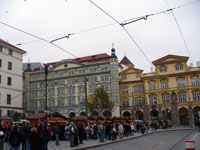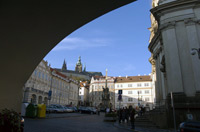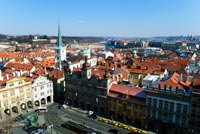Place de Mala Strana (Malostranské náměstí)
Hôtels les plus proches
- Hotel Best Western Roya … (285 m)
- Hotel U Páva (362 m)
- Hotel U Krále Karla (573 m)
- Hotel Roma (675 m)
- Botel Florentina (758 m)
Sites touristiques les plus proches
- Sternberg Palace (61 m)
- Église Saint-Nicolas (84 m)
- Tour du Pont de Petit V … (207 m)
- Vrtba Garden (226 m)
- Palais Wallenstein (233 m)
Since it was laid out in 1257, this square has been the heart of Lesser Town (Czech: Malá Strana), a district situated at the foot of the Prague Castle. The square is dominated by St. Nicholas Church, a impressive baroque church that occupies the center of the square.
Magnificent houses with Renaissance and Baroque façades border Lesser Town Square (Czech: Malostranské náměstí) on all sides. During the Middle Ages, when the square was the site of a market for the Prague Castle, the buildings had Gothic designs. A fire that broke out at the square destroyed most of the houses and they were rebuilt in Renaissance and later Baroque style. The latter dominates since only a few of the original Renaissance façades kept their original appearance, including the U Mecenaše House (House at the Maecenas) and the Town Hall of Lesser Town.
St. Nicholas Church
In 1673 the Jesuits built a college at the center of the square. Twelve houses, a school and a 13th century church had to make way for the new building, which divides the square in two. Adjacent to the college, the Jesuits built one of Prague's most impressive ecclesiastic buildings, the 18th century St. Nicholas Church, which replaced an older, Gothic, St. Nicholas church. Kilian Ignaz Dientzenhofer, who had built a namesake church at the Old Town Square, designed an ornately Baroque masterpiece crowned with a 70 meter (230 ft) high dome.
Holy Trinity Column
The lower part of the square was once the site of a pillory and gallows. There are no traces anymore of those grim symbols of the Middle Ages but the upper part of the square has a monument that celebrates the end of a disease that plagued the city throughout the Middle Ages: the bubonic plague. After a late outbreak of the disease was finally under control, the city decided to erect the Plague Column to celebrate the end of the plague.
The column, which is also known as the Holy Trinity Column, was designed by Giovanni Batista Alliprandi. Built in 1715, the monument consists of a small fountain surrounded by putti's. A large pedestal supports a soaring obelisk, which reaches a height of about 20 meter (66ft). The pedestal is decorated with statues created by Johann O. Mayer and Ferdinand Geiger. They depict patron saints including St. Wenceslas and St. John Nepomuk.
Notable Buildings
The largest building at Lesser Town Square is the Liechtenstein Palace (Lichtenštejnský palác), which occupies the west side of the square. It was built in the 1621 for Charles of Liechtenstein by reconstructing five existing houses. Charles amassed much of his fortune by confiscating properties of protestants after they were defeated at the Smiricky PalaceBattle of the White Mountain in 1620.
The largest palace on the north side of the square, flanked by small towers, is the Smirický Palace, originally built in Renaissance style at the turn of the 17th century. In 1763 it was renovated in a late Baroque style. In 1618, this was the site of the second defenestration of Prague - when protestants threw catholics out of a window - which led to the Battle of the White Mountain.
Adjacent to the Smirický Palace stands the Sternberg Palace (Šternberský Palác) - not to be confused with the larger Sternberg Palace at Castle Square. The left, receding part of the building was originally known as the Bašta (Bastion). This was the site where, in 1541, a devastating fire started that destroyed most of Town and a large part of Castle District. After the fire the house was rebuilt in a Renaissance style. Giovanni Battista Alliprandi later integrated the house in the Baroque Sternberg Palace.
Nearby the Sternberg Palace, along the east side, is the former Town Hall of Lesser Town, built in the early 17th century in a high-renaissance style and crowned with several decorative onion domes. The elegant House at the Maecenas along the square's south side at the upper part of Lesser town is an elegant example of earlier Renaissance architecture.
Source: a View on Cities
Photos
Plan
Opérateur
- Téléphone: +420 261 264 369
- E-mail: info@arcadira.eu
Information touristique
Tourist Information about Prague and Czech republic. History, Culture, Language, Currency, Visa and much more.
Liste des hôtels à Prague
Prague hôtels 3 *
- Botel Albatros
- Botel Florentina
- Botel Racek
- Hotel Ankora
- Hotel Arbes - Mepro
- Hotel Atos
- Hotel Donatello
- Hotel Globus
- Hotel Gloria
- Hotel ILF
- Hotel Legie
- Hotel Old Prague
- Hotel Olsanka
- Hotel Olympik Tristar
- Hotel Victoria
- King George´s House
Prague hôtels 4 *
- Hotel Adria
- Hotel Amigo
- Hotel Arkada
- Hotel Barceló
- Hotel Barceló Old Town
- Hotel Caesar Palace
- Hotel Corinthia Panorama
- Hotel Golf
- Hotel Holiday Inn Congress Centre
- Hotel Louis Leger
- Hotel Majestic Plaza
- Hotel Olympik
- Hotel Pyramida
- Hotel Roma
- Hotel Step
- Hotel U Krále Karla
- Hotel U Páva
- Hotel Yasmin
Prague hôtels 5 *
Contact
- Pragap Tour, s.r.o. (Arcadira)
- Liliová 10
- 110 00, Praha 1
- Česká republika
- Téléphone: +420 261 264 369
- Fax: +420 244 400 157
- Adresse électronique: info@arcadira.eu
- Facebook: www.facebook.com
- ICO: 25147412
- DIC: CZ25147412
© 2008-2024 Pragap Tour, s r.o. (Arcadira) | Tous droits réservés | Conditions commerciales | Created by Jaroslav Salivar


